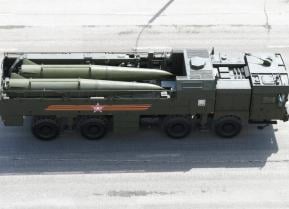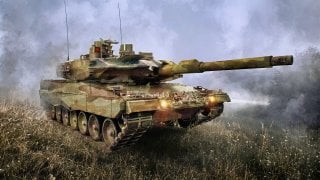How the Leopard 2 Tank Keeps Getting Better (As in More Lethal)
Since being introduced into service with the West German military in 1979, the Leopard 2 main battle tank (MBT) has earned significant praise as one of the best in the world.
Summary: This analysis discusses the continuous evolution of the Leopard 2 main battle tank (MBT) since its introduction in 1979, focusing on the modernized Leopard 2A7 variant. This advanced MBT features significant upgrades, including enhanced armor, improved energy systems, crew comfort enhancements, and a state-of-the-art weapon and battlefield management system. The article also highlights key specifications and features of the Leopard 2A7, such as its weaponry, protection systems, and mobility enhancements. Furthermore, the author distinguishes between the Leopard 2A7 and the 2A7+ models, with the latter being optimized for urban combat and fortified against RPGs and mines.
The Leopard 2A7 Tank – Improving Upon Perfection
Since being introduced into service with the West German military in 1979, the Leopard 2 main battle tank (MBT) has earned significant praise as one of the best in the world. As the successor to the Leopard 1, the German-made tank has been adopted by allied and partner nations around the world.
The platform has been steadily upgraded and improved, so much so that the latest variations are now practically tailor-made for specific roles. This includes the Leopard 2A7, a modernized version of the Leopard 2A6 MBT. It is equipped with new armor, an energy system, a crew compartment cooling system, and a new weapon/battlefield engagement/management system.
The 2A7 variant includes hull mine protection, a 17 kw Auxiliary Power Unit, a third-generation Attica thermal imaging unit for both Commander's Independent Sight and Gunners Sight, and a Spectus multi-spectral driver's vision device. The MBT's weapon system was also adapted for firing HE ammunition.
According to Army Recognition, the main armament of the Leopard 2A7 is similar to the Leopard 2A6 and consists of one L/55 120mm Rh 120 smoothbore gun, one MG3A1 7.62x51mm caliber coaxial machine gun, and a 7.62 mm MG3 machine gun mounted on loader hatch located on the left side of the roof turret. Eight 76mm smoke grenade dischargers are mounted on each side of the turret. The weapon system was further adapted for firing DM11 high-explosive (HE) rounds with an adjustable fuse.
The Leopard 2A7 is equipped with a collective NRBC system, power pack preheating, a crew compartment heater, a fire extinguishing system, electric bilge pumps, and an escape hatch in the hull floor, located behind the driver. To increase the comfort of the crew in hot and humid regions, the Leopard 2A7 is equipped with an energy system and crew compartment cooling system installed at the rear of the turret.
The first Leopard 2A7 was handed over to the German Army in Munich in December 2014, with more than a dozen vehicles produced for Tank Battalion 203, while an additional four went to the Armored Corps Training Center and another to the Technical School for Land Systems and School for Technology of the Army.
Not to be Confused With the Leopard 2A7+
There has been no shortage of confusion over the differences between the Leopard 2A7 and the 2A7+. However, it is important to note that while similar and based on the initial Leopard 2 design, the 2A7 variant was not optimized for urban combat.
This is where the 2A7+ model comes into play – as it was developed specifically to operate both in low-intensity and high-intensity conflicts. The MBT's tank's protection was increased by modular armor, while the frontal protection was enhanced via a dual kit on the turret and hull front, providing 360-degree protection against RPGs and mine protection to increase the survivability of the tank and its crew in urban operations.
The modular armor's system components were first employed by the Canadian military in Afghanistan. As with the 2A7, the 2A7+ variant can fire programmable High Explosive munitions, while the turret-mounted MG3 has been replaced with a stabilized FLW 200 remotely controlled weapon station.
Mobility, sustainability, and situational awareness have also been improved. The is equipped with an exterior telephone for dismounted personnel to aid in communication with friendly forces.
More 2A7+ Coming Soon
Last year, after the Czech Republic had donated the last of its Soviet-designed T-72 tanks to Ukraine, Prague announced plans to acquire the latest Leopard 2A7+ MBTs from Berlin.
Last summer, Hungary also received the first of its Leopard 2A7HU models, the configuration equipped with a new fire control system and remote weapon station as well as reinforced roof protection. In 2018, Budapest ordered a total of 44 Leopard 2A7 tanks and an additional 12 Leopard 2A4s from existing Krauss-Maffei Wegmann (KMW) stocks to the Hungarian Defense Forces for training purposes.
The deal was part of an effort to replace its Soviet-era arms, and the Leopard 2 tanks in their newest configuration, dubbed 2A7HU, were also slated to replace Russian-made T-72s.
Author Experience and Expertise: Peter Suciu
Peter Suciu is a Michigan-based writer. He has contributed to more than four dozen magazines, newspapers, and websites with over 3,200 published pieces over a twenty-year career in journalism. He regularly writes about military hardware, firearms history, cybersecurity, politics, and international affairs. Peter is also a Contributing Writer for Forbes and Clearance Jobs. You can follow him on Twitter: @PeterSuciu. You can email the author: [email protected].


